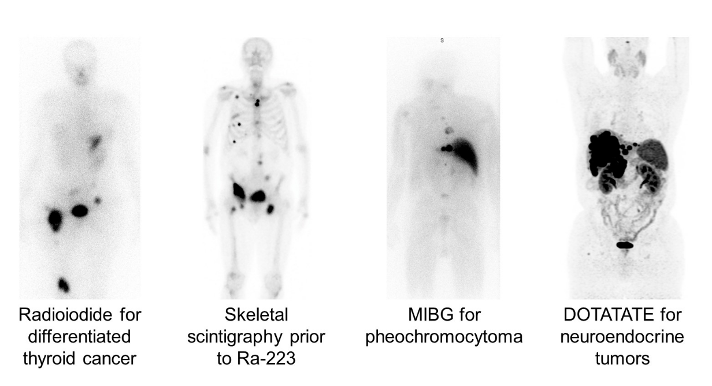Dr. McConathy notes that the theranostics concept has been around for a long time, dating back to radioiodine for the diagnosis and treatment of thyroid cancer in the 1940s, as well as measuring estrogen and progesterone receptors and HER2 expression in breast cancer to guide hormonal and targeted therapy. In nuclear medicine, the same or very similar agent can serve as both a diagnostic and a therapeutic agent. The typical paradigm is to perform diagnostic imaging to determine if a patient would benefit from the therapeutic form of the agent (ie whole-body imaging to assess the entire tumor burden). Examples of nuclear medicine theranostics in routine clinical use include radioiodide for differentiated thyroid cancer, skeletal scintigraphy prior to Radium-223, MIGB imaging for pheochromocytoma, and DOTATATE for neuroendocrine tumors:
A radiopharmaceutical is a drug labeled with a radionuclide targeting a biological process. Importantly, the overall chemical structure determines biological properties and the radionuclide determines imaging and/or therapeutic properties. Radionuclides are unstable (radioactive) nuclei that decay over time and may also be referred to as isotopes, radioisotopes, and radiolabels. Examples of diagnostic radionuclides (photons) include single-photon emitters (planar imaging and SPECT), as well as positron emitters (PET). Examples of therapeutic radionuclides include beta minus emitters, auger emitters, and alpha emitters. Beta and alpha particles damage DNA in radionuclide therapy, and include Sr-89, Y-90, I-131, Sm-153, and Lu-177. Radiopharmaceuticals are able to selectively deliver radioactivity to cancer cells, and some radiopharmaceuticals can be labeled for imaging and for therapy (theranostics approach). There are several emerging techniques that may impact therapies, including fluoroestradiol (FES) to detect estrogen receptor-positive breast cancer, and immune system imaging to guide immune checkpoint inhibitor therapy.
Dr. McConathy concluded his introductory talk on theranostics with the following summary points:
- Theranostic nuclear medicine approaches play key roles in the treatment of certain cancer, using diagnostic imaging to select patients for targeted radionuclide therapy
- A number of new targets being developed, including PSMA-based prostate cancer therapy as the next major class to likely be FDA approved
- Dosimetry to guide targeted radionuclide therapies has the potential to provide optimal therapy to individual patients
- Incorporation earlier in cancer treatment and combination with other disease-specific treatments could increase the utility of current and future theranostic agents
Written by: Zachary Klaassen, MD, MSc, Assistant Professor of Urology, Georgia Cancer Center, Augusta University/Medical College of Georgia, Augusta, Georgia, USA, Twitter: @zklaassen_md at the ASCO20 Virtual Education Program, #ASCO20, August 8-10, 2020


